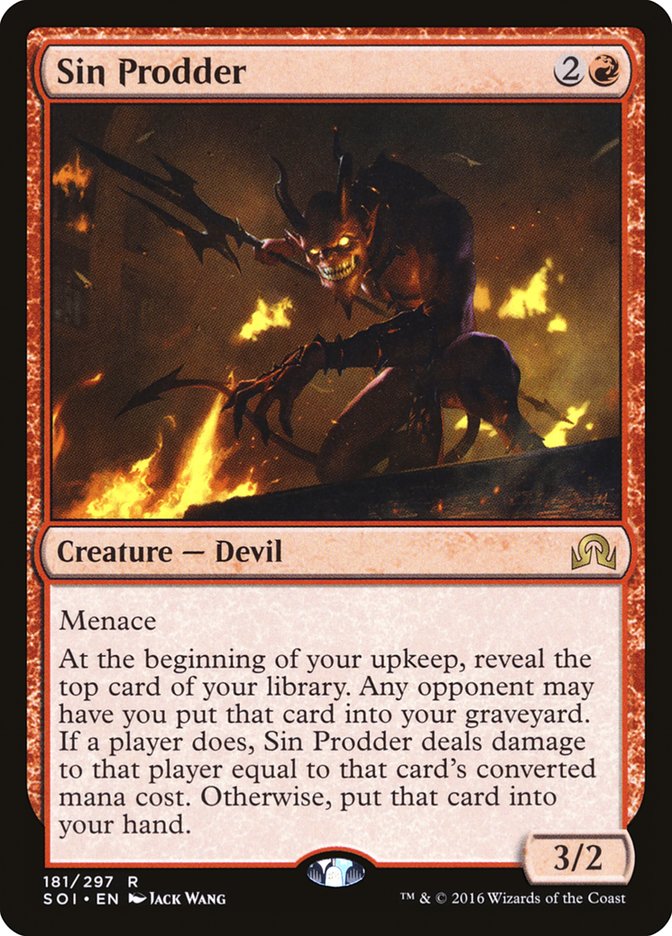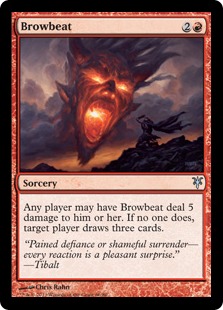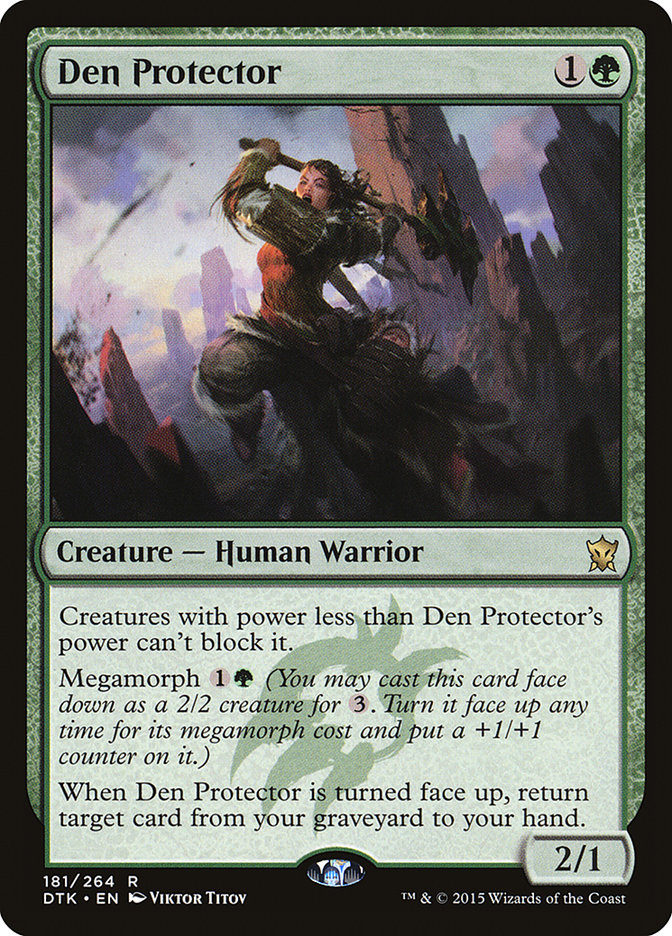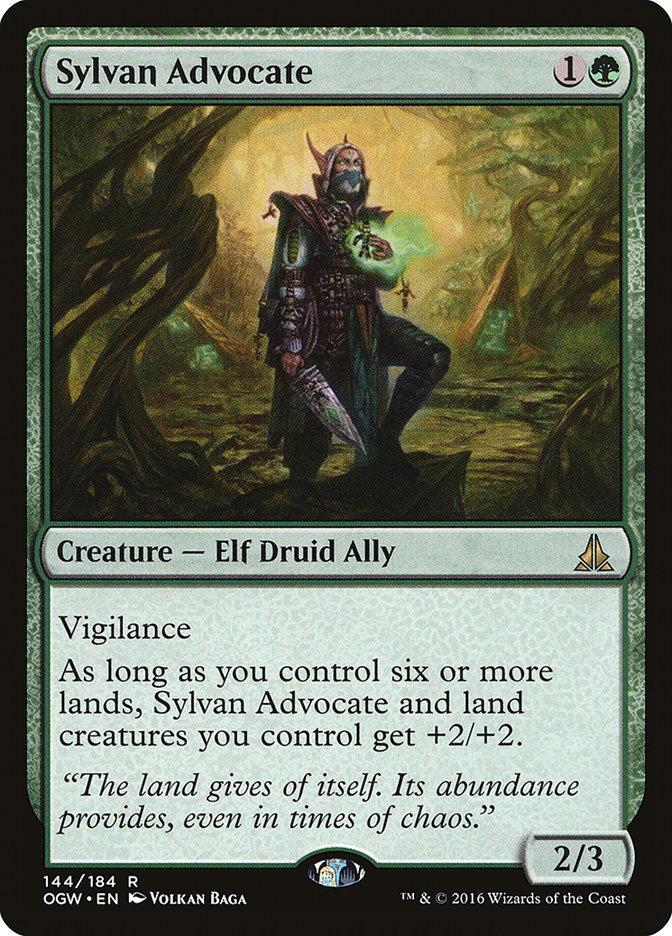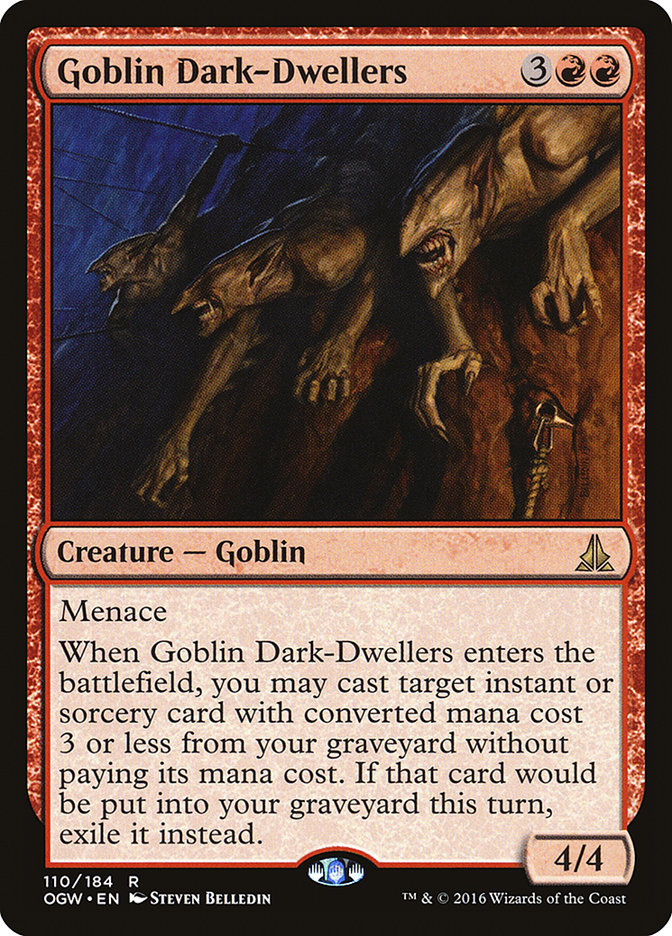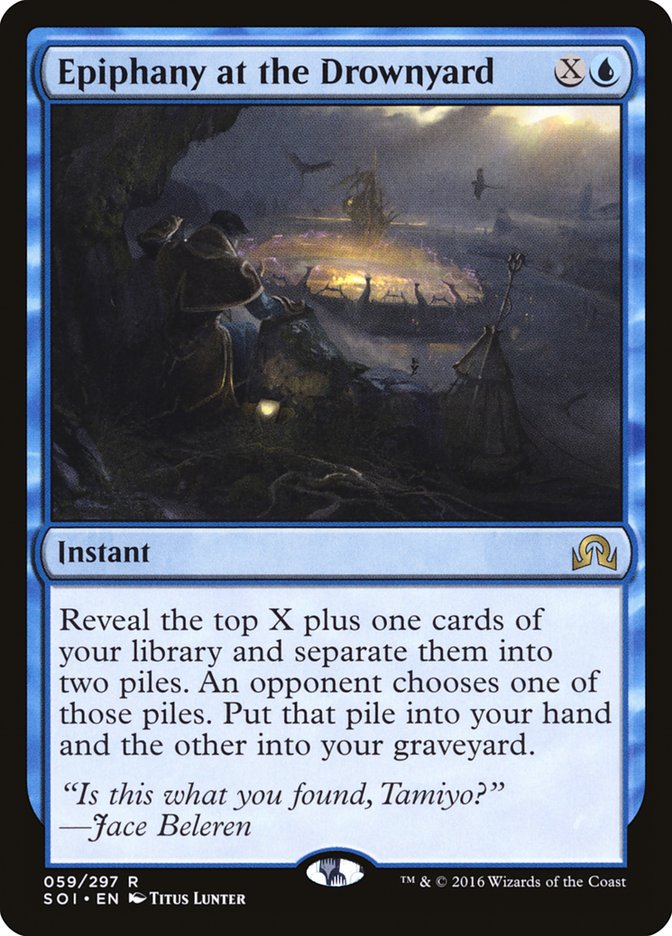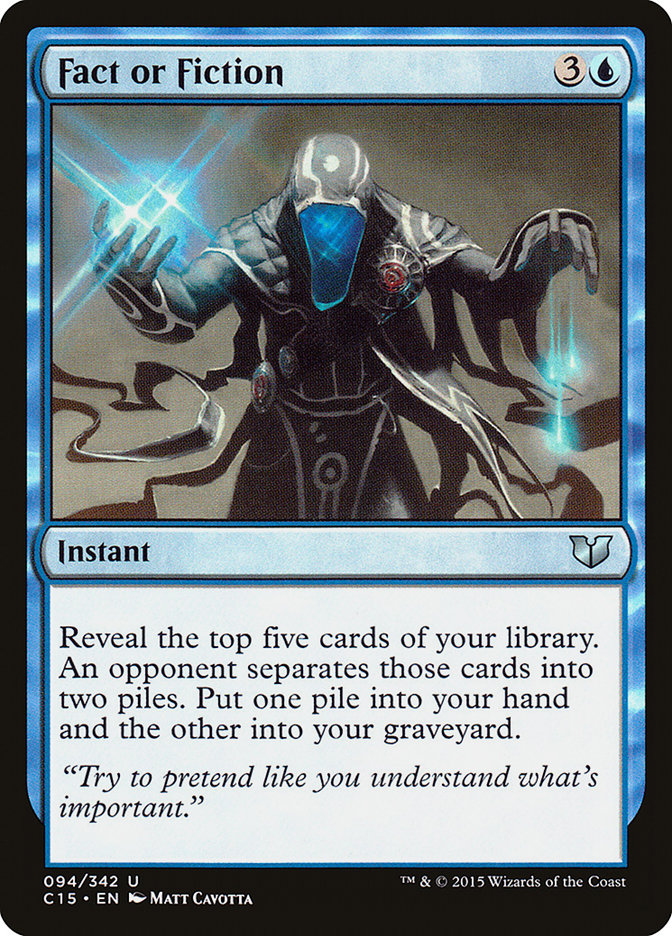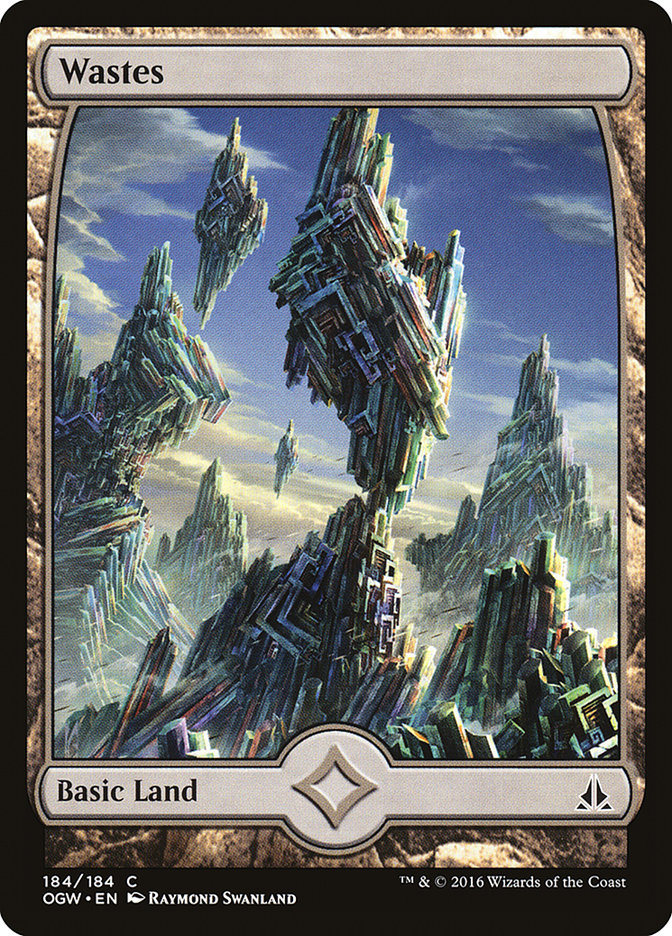No funny anecdotes.
No silly stories.
Today we jump right in to three cards of varying worth from Shadows Over Innistrad.
The Overrated
Sin Prodder looks like it has a lot going to it. It draws cards, deals damage, and provides a reasonably sized body with pseudo-evasion. It has also been the hot topic on social media, as people can’t seem to decide if this card is good or not.
Spoiler alert: it’s not.
At first glance, Sin Prodder seems to resemble one of the most iconic creatures of all time: Dark Confidant. It is fairly cheap, beats down reasonably well, draws you cards, and seems to fit right in to a proactive strategy. However, the devil is in the details.
Like all cards with the “punisher” mechanic, Sin Prodder ultimately puts the choice into your opponent’s hands. Your opponent has the ability to deny you cards should they choose, unless of course the damage is more detrimental and they would prefer to keep their life total safe. These valuations are constantly changing over a game of Magic, and allowing your opponent to decide which ones are important will often prove to be very ineffective.
This is nothing new, as it is pretty basic strategy. Most players understand why Browbeat isn’t a very good card. But the problems with Sin Prodder go further than that.
What deck actually wants this card?
Sin Prodder is capable of doing two things: dealing damage to players and potentially drawing nonland cards. It’s pretty safe to assume control decks really aren’t going to be that interested, as your opponent will have no problem just taking some damage to deny you cards. It’s also pretty safe to assume Sin Prodder is not going to be the centerpiece of some new combo deck.
This leaves two possible options:
Aggressive Decks
Putting Sin Prodder into your aggressive deck makes a lot of sense on the surface. Sin Prodder is a three-power creature for three mana that can deal damage or draw cards. If you are taking an aggressive stance and pressuring your opponent’s life total they are going to have a difficult time paying life to deny you cards, which means that Sin Prodder will be doing a passable Dark Confidant impression and drawing you some cards while it beats down.
However, there are some major issues.
The average mana cost of an aggressive deck is going to be very low. Most of your cards are going to cost between one and three mana, meaning the cost to deny you a card is going to be fairly low. Your opponent is probably going to be more than happy to pay a single life to deny you a Falkenrath Gorger, as you are not making the choice that tough for them.
The individual power level of cards in an aggressive deck is also going to be rather low. Once you make it into the midgame and need to battle through all the planeswalkers and powerful midrange threats in the format, drawing an extra Shock or Jackel Pup isn’t really going to make a huge difference in the outcome of a game. The soonest Sin Prodder can start drawing you cards is turn 4, and an aggressive deck really isn’t going to want the game to many more turns than that. Every turn that goes by greatly decreases an aggressive deck’s chances at winning.
Last, Sin Prodder is a three mana 3/2 that does nothing the turn it enters the battlefield. Aggressive decks need to take the initiative quickly and then continue to press their aggressive advantages as the early turns progress. Rather than press an early advantage, Sin Prodder seeks to slowly accrue advantage as the game progresses.
Midrange Decks
With it seeming pretty clear that Sin Prodder is unexciting in aggressive decks, the other obvious choice is to put the little Devil into midrange decks. Midrange decks are less interested in the potential damage output but very interested in accruing card advantage.
However, there are issues here as well.
With much higher average mana costs, Sin Prodder is poised to be more deadly if his sin is denied in a midrange deck, but that often won’t really matter. Midrange decks are much more interested in playing powerful singular threats and gaining card advantage than pressuring an opponent’s life total. This means that their opponent’s life total is almost secondary and an opponent is going to be able to take some damage to deny card advantage fairly easily. Midrange decks also have more robust manabases, meaning they play more lands and actually want to draw lands. Sin Prodder can never provide you with a land.
There’s also the recurring problem of Sin Prodder not actually doing anything the turn you cast it. In aggressive decks this is a problem because you need to keep applying pressure. In a more midrange deck it is important for your spells to affect the battlefield or help establish a defensive stance that will take you into the midgame.
Looking at midrange all-stars like Den Protector and Sylvan Advocate, it’s easy to see what makes a good midrange card: efficiency or guaranteed card advantage. Den Protector will always get you a card back if you cast it with two mana open, and Sylvan Advocate is a cheap blocker that gets significantly better late in the game.
Sin Prodder is a 3/2 that can’t block well, doesn’t affect the battlefield, and does nothing if it just dies, which it will do often because it dies to every single removal spell in the format. Even if it lives, then you need its trigger to hit a nonland card, and your opponent gets the final say in if you even get it or not.
As much as I like the design of the card, I think it’s doubtful that many sins will be prodded in the coming months. It does have a bit of synergy with delirium and other graveyard effects like Deathmist Raptor, but it is on the whole a pretty big miss.
The Underrated
Epiphany at the Drownyard is not Fact or Fiction.
However, it’s not Steam Augury Either. Being somewhere between “the best of all time” and “fringe playable” on the scale of instant-speed card draw spells is not a bad place to be.
This card is very different from last format’s big instant-speed card advantage spell, Dig Though Time. Dig Through Time was often pretty cheap to cast, but was very much card selection rather than raw card advantage. Dig Through Time provided you with the same amount of raw cards as Divination, but they would often be two very good cards. Card selection is great, but often control decks prefer raw card draw instead because they want to keep making land drops as well as casting spells.
In this way Epiphany at the Drownyard has more in common with Sphinx’s Revelation than Dig Through Time, although it’s clearly not as good. Scalability is a very valuable trait to have, and the mana-to-cards ratio is very good. Your opponent is not always going to know what you need, and even if they do, you can split the piles in a manner where you are still getting good value.
I look forward to making many Epiphany at the Drownyard piles in the future. The card is definitely not a powerhouse, but it is a very solid card draw spell that creates interesting game states and plays well with the graveyard. What’s not to like?
The Sleeper
This card is for real, and not just for Standard but for all formats as well.
It may look like a Lay of the Land, but this card does a lot of very good things.
In Standard this card can help fix your mana, put a sorcery in the graveyard for delirium, trigger prowess, and then turn into a one-mana Demonic Tutor for any creature. This is an early card in the graveyard to help flip Jace, Vryn’s Prodigy, and it lets Jace essentially cast any creature in your deck later in the game.
Aside from just being a good card, I think the most important impact of Traverse the Ulvenwald is how playable it makes Ruin in Their Wake. Rampant Growth would be insane in this format, as the format’s ramp deck is already good without it.
Between Evolving Wilds, Oath of Nissa, and Traverse the Ulvenwald, having a Wastes on turn 2 should be comically easy, which in turn makes Ruin in Their Wake very good. Like a super-charged Oath of Nissa, Traverse the Ulvenwald then helps you find gas in the late-game. Oath of Nissa even helps provide delirium!
I also see this card doing some work in Eternal formats as well. Thinking about how an average Tarmogoyf is usually a 4/5, it’s not hard to see that enabling delirium in Eternal formats is comically easy. This turns Traverse the Ulvenwald into a very powerful tutor that could be a great tool for any creature-based combo deck in either format.
This is the kind of card that can spark completely new decks in Eternal formats.
Overall this set looks awesome, and I am in awe of how many interesting and cool-looking cards are already spoiled. I can’t wait to start brewing! #SCGBALT is going to be one of the best events of the year and it can’t come soon enough.
Challenge Thursdays
Week 4 of Challenge Thursdays on my stream has come and gone, and many nightmares were weaved!
Creatures (14)
Planeswalkers (4)
Lands (23)
Spells (19)
- 4 Serum Visions
- 4 Delay
- 2 Thoughtseize
- 2 Doom Blade
- 3 Inquisition of Kozilek
- 3 Nihil Spellbomb
- 1 Dismember
Sideboard

The challenge, submitted by @Tomdon0783, was simple: “Build a Modern deck with four copies of Ashiok, Nightmare Weaver.” Not only was our deck awesome, but we almost managed to run the tables in our first League! A loss in the last round to the soon-to-be-banned U/W Eldrazi was our only blemish on the evening.
Today we once again shoot for 5-0, but first you need to select this week’s challenge:
As always the poll will end at 6:00pm EST, which will give me one hour to construct my deck. Then you can tune in at 7:00pm for the start of the stream. I will be playing an entire League with the challenge deck, tweaking it a bit, and then playing another League right after.
How many wins can I get? Cast your vote and tune in to my stream at 7:00pm to see how it goes!


